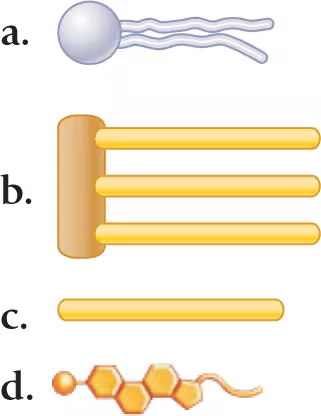 Back
BackProblem 1
Which of the following is (are) true concerning the atomic nucleus?
a. It contains the mass of the atom.
b. The negatively charged subatomic particles are here.
c. Subatomic particles can be ejected.
d. It contains subatomic particles that determine atomic number.
e. It contains subatomic particles that interact with other atoms.
Problem 2
Pick out the correct match(es) of element and number of valence electrons. Draw a planetary model of each atom to help you choose the best answer.
a. Oxygen—6
b. Chlorine—8
c. Phosphorus—5
d. Nitrogen—3
e. Carbon—4
Problem 3
Important functions of water include which of the following?
a. Provides cushioning
b. Acts as a transport medium
c. Participates in chemical reactions
d. Acts as a solvent for sugars, salts, and other solutes
e. Reduces temperature fluctuations
Problem 4
Alkaline substances include which of the following?
a. Gastric juice
b. Water
c. Blood
d. Lemon juice
e. Ammonia
Problem 5
Glucose is to starch as:
a. A steroid is to a lipid
b. A nucleotide is to a nucleic acid
c. An amino acid is to a protein
d. A polypeptide is to an amino acid
Problem 6
What lipid type is stored in fat deposits beneath the skin?
a. Triglyceride
b. Steroid
c. Vitamin D
d. Phospholipid
e. Prostaglandin
Problem 7
Absence of which of the following nitrogen-containing bases would prevent RNA synthesis?
a. Adenine
b. Cytosine
c. Guanine
d. Thymine
e. Uracil
Problem 9
The element(s) essential for normal thyroid function is/are:
a. Iodine
b. Iron
c. Copper
d. Selenium
e. Zinc
Problem 10
Factors that increase the speed of chemical reactions include:
a. Increasing the temperature
b. Increasing the particle size
c. Increasing the concentration of the reactants
d. Catalysts
Problem 11
Which of the following forms the basic structure of cell membranes?
Which is the basis for producing sex hormones?
Problem 12
Matter occupies space and has mass. Explain how energy must be described in terms of these two factors. Then define energy.
Problem 13
Name and provide the atomic symbols of the four elements that make up the bulk of all living matter. Which of these is found primarily in proteins and nucleic acids?
Problem 15
Define radioactivity. If an element has three isotopes, which of them (the lightest, the one with an intermediate mass, or the heaviest) is most likely to be a radioisotope, and why?
Problem 16
Define molecule as it relates to molecular substances and compounds.
Problem 17
Describe how the two 'generic' atoms shown below would form an ionic bond. Include in your answer where electrons come from, where they go, and why.
Problem 18
What are hydrogen bonds, and how are they important in the body?
Problem 19
Identify each of the following reactions as a synthesis, decomposition, or exchange reaction:
2Hg + O₂ 2HgO
Fe²¹ + CuSO₄ → FeSO₄ + Cu²¹
HCl + NaOH → NaCl + H₂O
HNO₃ → H⁺ + NO₃⁻
Problem 20
Distinguish inorganic from organic compounds, and list the major categories of each in the body.
Problem 21
Define pH. The pH range of blood is from 7.35 to 7.45. Circle the correct answer to complete the sentence: This is slightly (acidic / basic).
Problem 24
Mrs. Roberts, who is in a diabetic coma, has just been admitted to Noble Hospital. Her blood pH indicates that she is in severe acidosis (blood pH in the acid range), and the medical staff quickly institute measures to bring her blood pH back within normal limits. Note the normal pH of blood, and discuss why severe acidosis is a problem.
Problem 25
Sarah has a lower than normal amount of body fat. She tends to be chilly except on very hot days. Lauren has a higher than normal amount of body fat and tends to feel overheated most of the time. Explain the relative sensitivity to environmental temperature of these two women on the basis of information you have been given in the Organic Compounds section of this chapter.
Problem 26
Pediatricians become concerned about the potential for brain damage when an infant's temperature approaches 105°F. Which class of organic molecules is most likely to be damaged by high temperature? Explain why.

